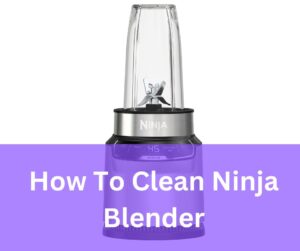Have you ever wondered, “Will an immersion blender scratch pots?” If you’re an avid home cook, you’ve likely encountered this question while considering the benefits of these handy kitchen gadgets. Immersion blenders, also known as stick blenders or hand blenders, offer a convenient way to blend soups and sauces right in the pot without the need for transferring hot liquids. However, the concern about potential damage to your cookware lingers. In this article, we delve into this query, exploring the possibilities of whether immersion blenders can scratch pots and providing you with valuable insights on using them safely. So, if you’re curious about preserving your pots while enjoying the convenience of immersion blending, stay connected with us for expert information and guidance.
Will An Immersion Blender Scratch Pots

Immersion blenders, those versatile hand-held kitchen tools, are beloved for their ability to puree soups, blend sauces, and create creamy smoothies right in the pot or bowl. However, the concern of whether using an immersion blender can lead to scratched pots is a common one. Here’s the answer:
No, immersion blenders typically do not scratch pots.
The reason is that immersion blenders come with a specially designed blending head that is made of materials like stainless steel or plastic, both of which are non-abrasive and safe for use with various types of cookware, including pots, pans, and bowls. When used correctly, immersion blenders should glide smoothly through your ingredients without causing any damage to the cooking vessel.
However, there are some essential tips to keep in mind to ensure that your immersion blender doesn’t inadvertently scratch your pots:
- Choose the Right Material: Opt for an immersion blender with a blending head made of stainless steel or high-quality plastic. These materials are less likely to cause scratches than rougher or metal-based alternatives.
- Maintain Careful Control: When using an immersion blender, ensure that the blending head remains submerged in the liquid or food you’re blending. Avoid dragging it along the bottom of the pot, which could potentially scratch the surface.
- Inspect for Damage: Before each use, examine the blending head for any signs of wear or damage. If you notice any sharp edges or cracks, it’s essential to replace the head to prevent potential scratching.
- Use Caution with Non-Stick Cookware: While immersion blenders are generally safe for most cookware, it’s a good practice to exercise extra caution when using them with non-stick pots or pans. Gentle, controlled blending is key to avoiding any unintended damage.
How to Prevent an Immersion Blender from Scratching Pots?
Preventing your immersion blender from scratching pots is essential to preserve both your cookware and the functionality of your blender. Here are the main points and steps to follow to avoid scratches:
-
Choose the Right Material:
- Opt for an immersion blender with a blending head made of stainless steel or high-quality plastic. These materials are non-abrasive and safe for most cookware surfaces.
-
Keep the Blender Head Submerged:
- When using your immersion blender, ensure that the blending head remains fully submerged in the liquid or food you’re blending. Avoid allowing it to touch the bottom of the pot, which could potentially scratch the surface.
-
Use a Gentle Touch:
- Maintain a gentle and controlled blending motion. Avoid applying excessive pressure or dragging the blender head against the pot’s interior. Allow the blender’s sharp blades to do the work without unnecessary force.
-
Inspect for Damage:
- Before each use, carefully examine the blending head for any signs of wear or damage. Look for sharp edges, cracks, or any irregularities. If you spot any issues, replace the head promptly to prevent potential scratching.
-
Caution with Non-Stick Cookware:
- Exercise extra caution when using your immersion blender with non-stick pots or pans. While the risk of scratching is minimal, it’s advisable to be gentle and avoid prolonged contact with the pot’s surface.
-
Avoid Abrasive Ingredients:
- Be mindful of the ingredients you’re blending. Avoid using your immersion blender with abrasive or hard materials that could potentially scratch the cookware, such as ice cubes or uncooked grains of rice.
-
Proper Cleaning:
- After each use, clean your immersion blender thoroughly, paying close attention to the blending head. Remove any food particles or residue that may have accumulated on the blades or around the head to prevent scratching in future uses.
-
Store Safely:
- When not in use, store your immersion blender in a safe location, such as a drawer or utensil holder, where it won’t come into contact with other kitchen tools or surfaces that could potentially damage it.
Never Use Immersion Blenders in Non-Stick Pots
Using caution when using immersion blenders in non-stick pots is essential to prevent potential damage to the pot’s surface. Here’s why you should avoid it:
- Risk of Scratching: Non-stick pots and pans have a delicate coating that can be easily scratched or damaged by abrasive materials or sharp objects. Immersion blender blades, while not typically sharp enough to cut through the non-stick coating, can still cause surface abrasions if excessive force is applied or if the blender head is dragged along the pot’s bottom.
- Preservation of Non-Stick Coating: Scratches or damage to the non-stick coating can compromise its effectiveness. A damaged coating may no longer provide the non-stick properties you rely on for easy cooking and cleaning.
- Safety Concerns: In rare cases, if the non-stick coating is damaged and begins to flake off, it can potentially mix with your food, posing health concerns. This is why it’s crucial to maintain the integrity of the non-stick surface.
- Prolonged Pot Lifespan: By avoiding the use of immersion blenders in non-stick pots, you can prolong the lifespan and functionality of your cookware, ensuring that it continues to serve you well for a more extended period.
- Alternative Cookware: To safely blend ingredients using an immersion blender, consider using alternative cookware such as stainless steel or glass pots or containers. These materials are less susceptible
How Immersion Blenders Work
Immersion blenders, also known as hand blenders or stick blenders, are versatile kitchen appliances designed to make blending and pureeing tasks more accessible and efficient. Unlike traditional countertop blenders, immersion blenders are hand-held and offer several advantages in terms of convenience and versatility.
Here’s how immersion blenders work:
- Design: Immersion blenders consist of a long, slender body with a handle and a blending head at one end. The blending head typically houses a motor and a set of sharp blades.
- Versatile Usage: Immersion blenders are incredibly versatile and can be used directly in pots, bowls, or other containers, eliminating the need for transferring hot or bulky ingredients. They are commonly used for tasks such as:
- Soup and Sauce Blending: Immersion blenders are perfect for pureeing soups, sauces, and gravies directly in the cooking pot, achieving a smooth and consistent texture.
- Smoothie and Beverage Preparation: They are great for quickly blending smoothies, milkshakes, and beverages right in the serving glass.
- Baby Food Preparation: Immersion blenders are a convenient tool for making homemade baby food by pureeing fruits, vegetables, and other ingredients.
- Whipping Cream and Eggs: They can be used for whipping cream, beating eggs, and creating fluffy mixtures for various recipes.
- Simple Operation: Operating an immersion blender is straightforward. You immerse the blending head into the container with the ingredients you want to blend, ensuring that the blades are fully submerged. Then, you turn on the blender using the power button or speed control located on the handle.
- Blending Action: Once activated, the motor in the handle drives the blades in the blending head, creating a vortex effect that draws ingredients towards the blades. As the blades rotate at high speeds, they chop and blend the ingredients into a smooth consistency.
- Variable Speeds: Many immersion blenders come with variable speed settings, allowing you to adjust the blending speed according to the task and the desired texture. Higher speeds are typically used for tougher ingredients, while lower speeds are suitable for gentler blending.
- Easy Cleaning: After use, immersion blenders are relatively easy to clean. Most models allow you to detach the blending head from the handle for easy washing. Some components may also be dishwasher-safe for added convenience.
FAQ:
Question: Will an immersion blender scratch pots?
Answer: Immersion blenders are generally safe to use in most pots, as long as they have non-abrasive blending heads made of materials like stainless steel or high-quality plastic. However, caution should be exercised to prevent scratching.
Question: Can immersion blenders scratch non-stick pots?
Answer: While immersion blenders are less likely to scratch non-stick pots compared to metal utensils, it’s advisable to exercise caution to avoid damaging the non-stick coating.
Question: What type of blending head is safest for pots?
Answer: Blending heads made of stainless steel or high-quality plastic are considered safe for use with pots, as they are less likely to cause scratches.
Question: Are there any tips to prevent immersion blenders from scratching pots?
Answer: Yes, to prevent scratching, always keep the blending head submerged in the ingredients, use a gentle blending motion, and inspect the blending head for damage before use.
Question: Can immersion blenders be used in glass pots?
Answer: Yes, immersion blenders can be safely used in glass pots, as glass is a non-abrasive material that is resistant to scratching.
Conclusion:
In conclusion, the question, “Will an immersion blender scratch pots?” revolves around ensuring the safe and proper use of these versatile kitchen tools. Immersion blenders, with non-abrasive blending heads, are generally safe for most pots and cookware. By following simple guidelines, such as keeping the blending head submerged, using a gentle touch, and choosing the right materials, you can enjoy the convenience of immersion blending without worrying about potential scratches to your cookware.



